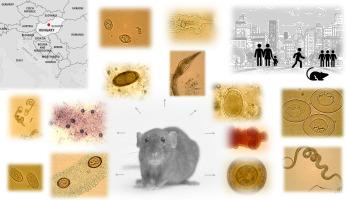首次调查匈牙利同类环境中褐鼠(Rattus norvegicus)的内寄生虫感染情况
IF 1.4
Q3 PARASITOLOGY
Veterinary parasitology, regional studies and reports
Pub Date : 2024-10-20
DOI:10.1016/j.vprsr.2024.101141
引用次数: 0
摘要
城市中的老鼠是人畜共患内寄生虫的重要孳生地,对人类健康构成严重威胁。本研究旨在检测布达佩斯野生棕鼠(Rattus norvegicus)中常见的内寄生虫,以解决匈牙利目前缺乏内寄生虫调查的问题。对灭鼠后收集的 131 只老鼠的尸体进行了检查。发现了三种人畜共患病蠕虫:空肠中的 Hymenolepis nana 和 Hymenolepis diminuta 以及肝脏中的 Calodium hepaticum。此外,还检测到了非动物源性寄生虫,包括艾美拉虫属、鼠恩塔米阿米巴虫、海绵异虫、巴西尼泊斯龙线虫、胃线虫、环状龙线虫、鼠线虫(肠道)和膀胱线虫(膀胱)。蠕虫感染率为 83.9%,男女感染率和感染强度无明显差异。这些发现凸显了人畜共患寄生虫在城市鼠群中造成的潜在公共卫生风险,强调了监测以减少可能的人类感染的重要性。这项研究展示了一种既实用又经济的监测城市鼠群的方法。建议进一步开展大规模研究,以更好地了解匈牙利鼠群中的寄生虫情况,并充分利用鼠类控制项目的数据。本文章由计算机程序翻译,如有差异,请以英文原文为准。

The first survey of endoparasite infection in the brown rat (Rattus norvegicus) from a synanthropic environment in Hungary
Urban rats are significant reservoirs of zoonotic endoparasites, posing serious health risks to humans. This study aimed to detect common endoparasites in wild brown rats (Rattus norvegicus) in Budapest, addressing the current lack of endoparasite surveys in Hungary. Carcasses of 131 rats collected following extermination were examined. Three zoonotic helminths were identified: Hymenolepis nana and Hymenolepis diminuta in the jejunum, and Calodium hepaticum in the liver. Additionally, non-zoonotic parasites were detected, including Eimeria spp., Entamoeba muris, Heterakis spumosa, Nippostrongylus brasiliensis, Eucoleus gastricus, Aonchotheca annulosa, Syphacia muris (intestine), and Trichosomoides crassicauda (urinary bladder). Helminth infection prevalence was 83.9 %, with no noticeable differences in prevalence or infection intensity between sexes. These findings highlight the potential public health risk posed by zoonotic parasites in urban rat populations, emphasising the importance of surveillance to mitigate possible human infection. This study demonstrates a practical and economical approach to monitoring urban rat populations. Further large-scale studies are recommended to better understand the parasitic landscape in Hungary's rat populations, leveraging data from rat control programs.
求助全文
通过发布文献求助,成功后即可免费获取论文全文。
去求助
来源期刊
CiteScore
2.90
自引率
7.10%
发文量
126
审稿时长
97 days
期刊介绍:
Veterinary Parasitology: Regional Studies and Reports focuses on aspects of veterinary parasitology that are of regional concern, which is especially important in this era of climate change and the rapid and often unconstrained travel of people and animals. Relative to regions, this journal will accept papers of the highest quality dealing with all aspects of disease prevention, pathology, treatment, epidemiology, and control of parasites within the field of veterinary medicine. Also, case reports will be considered as they add to information related to local disease and its control; such papers must be concise and represent appropriate medical intervention. Papers on veterinary parasitology from wildlife species are acceptable, but only if they relate to the practice of veterinary medicine. Studies on vector-borne bacterial and viral agents are suitable, but only if the paper deals with vector transmission of these organisms to domesticated animals. Studies dealing with parasite control by means of natural products, both in vivo and in vitro, are more suited for one of the many journals that now specialize in papers of this type. However, due to the regional nature of much of this research, submissions may be considered based upon a case being made by the author(s) to the Editor. Circumstances relating to animal experimentation must meet the International Guiding Principles for Biomedical Research Involving Animals as issued by the Council for International Organizations of Medical Sciences (obtainable from: Executive Secretary C.I.O.M.S., c/o W.H.O., Via Appia, CH-1211 Geneva 27, Switzerland).

 求助内容:
求助内容: 应助结果提醒方式:
应助结果提醒方式:


